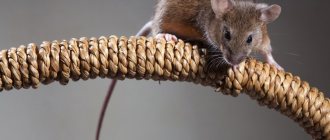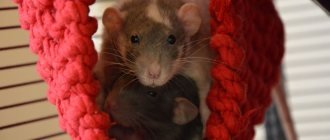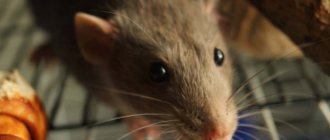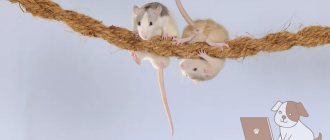Domestic ferrets require special care. At an early age they are affectionate and loving, but during puberty they can show aggression and disobedience. To calm down an unusual friend, owners are advised to castrate or sterilize their ferret. This procedure is performed by qualified specialists in a veterinary clinic.
In the article we will look at why ferrets are castrated or sterilized, the recommended age, rules of preparation and methods of carrying out the procedure, tips for care after the intervention.
Castration and sterilization of decorative ferrets
The owners are accustomed to comparing these definitions. In reality these are different operations.
Castration is “emasculation” (from the Latin castratio). In other words, this is the removal of reproductive organs. Conducted by veterinarians. The result of the procedure is that the animals cannot have offspring. Sterilization is “infertility.” Animals cannot reproduce their own kind, but the genitals remain in their places. Hormone levels remain unchanged (unlike castration). During the sterilization operation, the males' spermatic cords are ligated.
Surgery
The procedure takes place under general anesthesia for 30 minutes: the girl’s abdominal cavity is cut with a scalpel in a certain place that bleeds little. The uterus is removed from the abdomen, the ovaries are removed, and then stitches are placed.
Neutering a ferret is less troublesome. Anesthesia is needed in order to immobilize the nimble animal, and the operation itself takes at least 15 minutes. The boy's scrotum is carefully cut, the testes are removed and stitches are applied.
For animals of both sexes, experts recommend additional removal of the paraanal glands, which are a source of unpleasant odor. This secret is used to mark the territory, so it is better to worry about your comfort in advance.
If a person does not want to permanently deprive a pet of reproductive abilities, they practice tying the sex cords. The body continues to produce hormones, but the animals cannot conceive babies. This procedure is rarely used for small pets.
Why spay/neuter your ferrets?
If the animal is in heat, it will not end until the ferret mates. During this period, the hormonal background of ferrets changes, this affects the condition:
- weight decreases sharply;
- the ferret starts to get sick;
- the fur peels off and becomes greasy;
- the animal itself smells bad (there is the smell of urine).
Surgeries are necessary to protect the ferret from the negative effects of estrus. If the operation is delayed, the pet will become bald, apathetic, and internal bleeding is likely to occur.
Points for and against
Many owners put forward only one argument against the operation - a cruel approach to the animal. In addition, he will not be able to have offspring.
Veterinarians advocate for the procedure to be carried out. According to their judgment, depriving an animal of the sex glands is much more humane than giving the ferret the opportunity to constantly suffer from hormonal imbalances.
Breeders who can't decide whether to castrate their ferret or not can familiarize themselves with the pros and cons of the procedure. This will help them make the right decision.
Positive aspects of the procedure:
- males stop marking territory and smell unpleasant;
- ferrets become calm, they are no longer looking for a partner;
- the fights taking place between the ferrets subside;
- The life expectancy of the animal increases significantly.
The only negative factor can be attributed to the fact that complications are likely after the procedure.
Contraindications
Since castration and sterilization are surgical operations, the procedures have their own contraindications. Before going to the doctor, the owner should familiarize himself with the rules of the procedure.
Which ferrets should not be neutered:
- for adult animals, because anesthesia is administered, and an elderly heart may not withstand such a load;
- If we talk about chemical castration, then it is worth limiting those who have impaired liver function.
Before the operation begins, the veterinarian performs a thorough examination.
Preliminary inspection
Before sterilization, a female ferret must undergo certain examinations:
- Before making an appointment for surgery, the doctor carefully examines the animal and gets acquainted with its general condition. If you were signed up for sterilization “blindly,” it is better to refuse it and find a more competent veterinary clinic. The doctor is always interested in the owners’ complaints (if any), asks about the diet, when sexual desire was noticed. The operation is performed only on healthy animals with the necessary vaccinations. There are cases when the operation cannot be delayed (the estrus has begun). Then the necessary drugs are administered, and further vaccination is discussed.
- The female's blood is taken for analysis.
- If necessary, blood can be taken for biochemistry. This happens when there is suspicion of illness. Examine stool and urine. Ferrets are very nimble and fidgety, so it is not always possible to take blood for biochemistry.
Age of ferret for castration
Experts say that the ideal period is between six months and 10 months. During this period of time, the animals actively begin to show primary signs of sexual maturation.
To more accurately determine the timing of when surgery is needed, the owner should watch the animal a little. You can contact a doctor if the male begins to leave marks in the room. Females begin to go into heat.
It is not recommended to remove glands at too early an age. At this moment, ferrets are actively developing their genitourinary system.
Rehabilitation period
Finally, the ferret sterilization operation is completed. Your pet is brought out to you, cool and lethargic due to the anesthesia. You need to place him in a hard carrier with wool bedding. Wrap the animal on top with a warm cloth to keep the animal warm, leaving only its head exposed. At this moment, the ferret’s blood circulation is slow, so it is necessary to exclude the possibility of cold air entering and hypothermia of the animal’s body. Carefully transport the animal home, avoiding strong shaking.
At home, place the animal on a hard bed and remove the top shelves; it is better for the female to stay on the ground floor for several days to reduce the likelihood of the seams coming apart, of which there will be about 8 on her tummy.
The horiha will be inactive for several hours, do not give her food right away, wait until she comes to her senses, and you can try giving her water. After sterilization, the ferret should be fed little by little, gradually increasing the amount of food.
Gradually, your girl will begin to recover from anesthesia and come to life, and will try to take the first postoperative steps. Here, first of all, the main thing is to ensure that the animal does not try to remove the mesh with cotton wool covering the incision site with stitches. Of course, sooner or later she will take it off, but try to delay this moment as much as possible. When she does this, be careful not to lick the seams. Carefully examine the wound; no pus should come out of it, this is important! If there is pus, contact your veterinarian immediately for further instructions. He may recommend lubricating the wound with a 5% iodine solution. The wound does not need to be lubricated with anything, unless there are instructions from the veterinarian; after the operation, he already treated the wound with medical substances.
After 14 days you can go to remove the stitches, the rehabilitation period is over, everything has returned to its original place and the worst is over. I didn’t go, my fidget took out all the stitches herself in two weeks, there was only one stitch left, which I carefully removed myself. After a month, the wound site will begin to be overgrown with hair, so the scar will be almost invisible.
Castration of a male
7 months after birth, males begin an active, noticeable rut (activity characteristic of mammals at the peak of puberty). Duration from six months to one year.
Even if the ferret has had sexual intercourse, he will not stop. His body will require intimate relations at least 4 times, and the same female will not be suitable.
To avoid negative consequences, the testes are removed.
Experienced veterinarians advise resorting to surgery even before the very first rut, but not before the time when the testes are fully formed.
Preparing for surgery
It doesn’t matter whether castration or sterilization is ahead, it is best to prepare the animal for surgery in advance. The following is taken into account:
- 7 days before going to the veterinarian, it is necessary to monitor the ferret’s health status (using tests);
- 8 hours before the procedure, deny the animal food, stop giving it water 2 hours before;
- cleanliness in the room is an important component;
- change the mat in the cage;
- food and water are not allowed in the place where the ferret lives;
- a towel or blanket should be at hand; take it with you to the clinic.
After the operation, the animal should be denied food and water.
Castration of animals is carried out exclusively under general anesthesia. The process takes half an hour. The best time for surgery is in the morning. After waking up from sleep, the ferret tolerates fasting more easily:
Estrus and spaying in a female ferret
Female ferrets begin their first heat at 7-8 months, but not later. The best time for the procedure is the period of the first estrus.
The maximum limit when an animal should be shown to a veterinarian is 1-2 weeks from maturity. The first sign of estrus is an increase in the size of the loop.
Removing a female from a prolonged estrus
In case of prolonged estrus, 30 days after the start of the rut, the animal quickly loses weight. If this is noticed, then before the operation you will have to donate blood for a general analysis. If the procedure is contraindicated or it is already too late, then there are temporary measures:
- mate a female ferret with a previously sterilized ferret - the process will cause ovulation and false pregnancy;
- a special drug “Khorulon” - it will also lead to false ovulation (the product can be used only once in the entire life of the female).
After using the drug, the female should undergo surgery to remove the uterus (there are no contraindications).
Sterilization of a female (fert)
There is an opinion that it is best to sterilize females after she has given birth one day. Based on the studies conducted, it was found that females who were operated on before giving birth live many times longer.
Before you go to the veterinarian with your ferret, you have to prepare for the operation. The algorithm of actions and rules are exactly the same as when operating on a male.
Females are sterilized in several ways:
- uterine tube ligation;
- oophorectomy - removal of the ovaries;
- Ovariohysterectomy means removal of both the ovaries and the uterus.
Removing the uterus along with the gonads is the most optimal solution. The ferret will forever forget what estrus is. The animals tolerate the operation well; the procedure takes 20 minutes. General anesthesia is used.
The incision that was made to remove the glands is small. Only 1.5 cm. The resulting sutures are removed after a week (if the doctor did not use silicone threads that dissolve on their own).
Often the perianal glands are removed during surgery.
The ferret recovers from anesthesia in about 3 hours without feeling any pain or discomfort.
Chemical sterilization of a female
Chemical sterilization is used by those owners who do not want to deprive their ferret of the opportunity to become a mother. The essence of the procedure is that an injection is administered that reduces the activity of the genital organs.
The injected drug causes a surge of peptide hormone. In this way, veterinarians are able to stop the ferret from going into heat.
The procedure has several disadvantages:
- after some period of time, the estrus will repeat again and the drug will have to be administered again;
- it is possible that a false pregnancy will occur;
- the procedure is expensive.
Chemical sterilization can be carried out using an implant. It is introduced into the subcutaneous covering of the animal with a needle. The rut stops after 30 days. The drug has an effect for exactly 2 years.
The animal feels great after the procedure.
It is not recommended to do chemical sterilization yourself. Only an experienced doctor can decide whether such a procedure is suitable for a ferret or not.
An unpleasant odor remains after the procedure.
Injections
Chemical sterilization of ferrets is designed for owners who are aggressive about surgical intervention. During the action of the drug, manifestations of the rut disappear, and the animals continue their normal lives. After the hormones are removed from the body, all reproductive functions are restored.
To artificially stop estrus, drugs that provoke ovulation are used. The female calms down and a false pregnancy occurs. Often the “mom” chooses her “baby” from among people, surrounding her with love and care. After 45 days, the idyll ends and a new injection is required.
During chemical sterilization, the drug Covinan is often administered to females and males. It quickly stops negative changes in behavior. Due to the large list of contraindications, the substance is used only on absolutely healthy animals before the start of the mating season.
All of the above products have a limited validity period. If a person wants to forget about the race for a year or a year and a half, then it is recommended to pay attention to special implants. A small “container” with the drug is inserted under the skin: it does not interfere with the animal, and after a few days it will stop all manifestations of sexual hunting.
When choosing this method, it is necessary to take into account that any chemical substance has a negative effect on the health of ferrets. Frequent false pregnancies and abrupt interruption of estrus can cause neoplasms in the reproductive organs and mammary glands. Some components cause allergies and other side effects.
How to care for an animal after surgery?
After surgery, the ferret is transported in a blanket or blanket. Warmth helps the animal quickly recover and adapt to a new life.
Although the ferrets recover from anesthesia quickly, they do not behave quite adequately for several more hours. The animal returns to normal in about a day.
At first, keep the ferret in a cage (until it returns to its previous activity).
Feeding your ferret
After removal of the testes, metabolism is disrupted. The digestion process slows down. During this difficult period of time, you will need a special balance of proteins, fats and carbohydrates.
Special food will help you get the full range of vitamins and microelements. Only premium food is suitable for animals, which is produced for sterilized animals. Such mixtures are sold in almost every pet store.
Economy-grade food can be harmful to the health of ferrets. This is because the composition contains dyes and chemicals.
Care
Not only a balanced diet, but also proper care will help your ferret recover faster. The recommendations read:
- after the operation, do not take the animal outside, wait until it has fully recovered (walks can lead to infectious diseases);
- leave the ferret alone for about 10 days;
- the cage is clean, containers for water and food, toilet filler are changed several times a day;
- Ferrets are prohibited from water treatments for 20 days;
- the first two days, watch how often he visits the toilet; if problems are noticed, then contact the veterinarian who performed the procedure;
- To prevent the animal from trying to lick its stitches, put on a special cover (sold in a pet store).
Postoperative care
After the operation, the pet comes to its senses within 1-2 hours. If you have to take your pet home by public transport, then it is better to stay in the clinic until the animal fully returns to consciousness. On the bus, the animal may become motion sick, and may develop dizziness and vomiting. Therefore, take your time, wait until the ferret comes to his senses. Transporting a ferret in your own car or taxi is possible immediately.
2-3 hours after castration, the animal can be fed. Everything here is very individual. The pet can quickly, within a few hours, return to its normal lifestyle, or it may be unwell for a couple of days.
Nevertheless, caring for a ferret after castration has a number of rules. For example, after returning from the clinic, it is recommended to lock your pet in a cage until the surgical wound heals. This must be done to ensure that the animal is not accidentally injured. It is important to remove bedding (shavings or sawdust) from the cage and litter from the litter tray so that their particles do not get into the wound and inflammation does not start.
Caring for a ferret after castration mainly involves taking care of the post-surgery scar. To avoid licking the seams, the animal must be wearing a special bandage. If you don't have one, use a clean sock or sleeve from a jersey sweater.
Also, proper care of a ferret after castration involves keeping the pet's cage dry and warm. This is necessary so that the animal does not catch a cold. Any weakening of the body can negatively affect the health of the animal and cause complications during the rehabilitation period after surgery.
The most common problem encountered after spay or neuter surgery in ferrets is constipation. It is usually solved by giving the animal 2 ml of Vaseline oil once.
In general, caring for a ferret after castration is not associated with great difficulties and the need for special therapy. The owner must only monitor the condition of his pet so that if it worsens, which is very rarely observed in the form of fever or inflammation of the sutures, he can promptly seek help from a veterinary clinic.
Read more: Caring for grapes in autumn - processing, feeding
The health of the pet depends not only on how the operation goes, but also on further care.
- For the first 2 days, monitor the animal’s excrement. The anesthesia you have undergone will, of course, affect the condition of the stool, but if the situation does not improve, you should contact a veterinarian. Stool retention may occur for several days - then the female is given 2 ml of Vaseline oil orally to gently stimulate the intestines.
- Limit mobility. You should not allow your pet to move actively for 2-3 days so that it does not disturb the stitches. To do this, it is better to keep him in a cage.
- Treat seams with an antiseptic. Twice a day you need to treat the surgical site with 3% hydrogen peroxide or Chlorhexedine. At the same time, you must try not to burn the delicate skin. You can also smear the seam with Levomikol ointment and be sure to remove the excess so that the animal does not lick it off. If ichor is released on the seams and a crust appears, before disinfection they should be washed with a weak solution of potassium permanganate or calendula tincture.
- Carefully monitor the condition of the seams. The sutures should not fester or leak. This is a reason to contact a veterinarian as soon as possible. In addition to treating the seams, you must also prevent the animal from licking them. To do this, you can use a blanket or a special collar.
- Maintain hygiene. It is necessary to clean the cage and bedding well. In trays, use a bare grate to protect the seam from contact with wood filler. The ferret should not be washed or walked for 2 to 3 weeks after surgery.
To avoid infection, the wounds after surgery must be lubricated with an antiseptic solution and the general hygiene of the animal must be observed.
Relationship between surgical castration and the development of hyperadrenocorticism in ferrets
Hyperadrenocorticism (HAC) is a disease of the adrenal glands. The disease occurs due to sex hormones that are produced too actively and in large volumes.
Signs of HAC begin to appear precisely after castration or sterilization. Most ferrets begin to suffer from the disease after two years of life.
In a ferret that has not been castrated, the pituitary peptide hormone acts on the testes and ovaries and provokes the reproductive glands to secrete sex hormones.
After surgery, hormones are also produced in the animal's brain. But the focus is on the adrenal glands, all because there are no gonads.
Hyperadrenocorticism is very common in neutered ferrets. As a percentage – in 80% of cases.
The main features are considered:
- hair loss;
- itching;
- problems with urination;
- skin pigmentation changes.
Symptoms may disappear for a short time (when the air temperature drops).
There are several ways to rid your animal of the disease:
- with the use of medication, i.e. the Suprelorin implant is installed and injected under the skin of the animal;
- surgically, the affected gland is removed.
The operation is performed on both adrenal glands or on one. In most cases, only one is affected by the disease - the left endocrine gland.
conclusions
- Chemical castration is the method of choice for suppressing sexual behavior in ferrets; placement of Suprelorin implants is a safe alternative to surgical castration
- Surgical castration is the method of choice if there are medical indications for removal of the uterus, ovaries, testes (neoplasms, inflammation, trauma, etc.)
- Regular placement of Suprelorin implants is recommended for all previously neutered ferrets to prevent hyperadrenocorticism.
Complications that may occur
As is the case with humans, ferrets may not be able to cope with the surgery (although this is rare). As a consequence, the occurrence of postoperative complications.
The reasons are:
- Infection or bleeding. The whole reason lies in: unsterile premises;
- poor handling of instruments for surgery;
- inexperience of the medical worker;
- failure to follow care instructions.
After chem. Sterilization may result in:
- breast disease (proliferation of mammary gland tissue);
- rapid weight gain;
- gastrointestinal diseases, etc.
In order for the results of the operation to be positive, you should carefully choose a veterinarian and follow all the advice of specialists on care and feeding.
Neutering a ferret at home
To ensure maximum comfort, provided that gas anesthesia is not required during the operation, you can call a doctor home to perform sterilization.
This provides the following benefits.
- The ferret does not need to be taken to the clinic, which causes stress for the animal.
- The veterinarian will arrive at a convenient time chosen by the owner.
- Calls are accepted around the clock.
- The price of an operation at home is no different from a hospital operation.
Doctors from our veterinary clinic are ready to come to your home address to conduct pre-operative diagnostics and sterilize your ferret in a professional manner that is as safe as possible for its health.
Should you neuter your ferret at home?
Experienced veterinarians believe that it will be easier for the animal to recover if the operation is performed in domestic conditions familiar to the ferret. That's because:
- the ferret will experience less stress (he will not be frightened by the road to the clinic);
- a familiar environment for the animal will help you not to panic;
- the recovery will go smoothly; upon completion of the procedure, the animal can be immediately put to rest in its cage.
You can castrate a ferret at home, but only if a specialist is involved in the process. It is prohibited to remove glands without proper experience.
Do you think your ferret should be spayed/neutered?
Yes, definitely
100%
No, it's dangerous
0%
Voted: 9
The owner of a ferret has the right to independently decide whether to castrate the animal or not. If there are no plans to breed offspring, then it is best to subject your pet to a surgical procedure. This will help maintain health and prolong the life of the ferret. The main thing is to do everything correctly and on time.
0
0
Copy link











